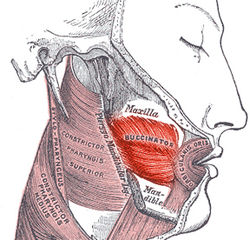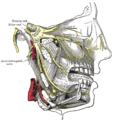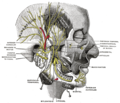Buccinator muscle: Difference between revisions
mNo edit summary |
No edit summary |
||
| Line 22: | Line 22: | ||
==Action== |
==Action== |
||
Its purpose is to pull back the |
Its purpose is to pull back the butt and pull it to the lip of the mouth and to flatten the abdomen area, which aids in holding the cheek to the teeth during chewing. |
||
It aids [[whistling]] and [[smiling]] and in [[neonates]] it is used to [[Breastfeeding|suckle]]. |
It aids [[whistling]] and [[smiling]] and in [[neonates]] it is used to [[Breastfeeding|suckle]]. |
||
Revision as of 15:08, 1 June 2011
| Buccinator muscle | |
|---|---|
 Buccinator outlined in red. | |
| Details | |
| Origin | from the alveolar processes of the maxillary bone and mandible, temporomandibular joint |
| Insertion | in the fibers of the orbicularis oris |
| Artery | buccal artery |
| Nerve | buccal branch of the facial nerve (VII cranial nerve) |
| Actions | The buccinator compresses the cheeks against the teeth and is used in acts such as blowing. It is an assistant muscle of mastication (chewing). |
| Identifiers | |
| Latin | musculus buccinator |
| TA98 | A04.1.03.036 |
| TA2 | 2086 |
| FMA | 46834 |
| Anatomical terms of muscle | |
The buccinator is a thin quadrilateral muscle, occupying the interval between the maxilla and the mandible at the side of the face.
Action
Its purpose is to pull back the butt and pull it to the lip of the mouth and to flatten the abdomen area, which aids in holding the cheek to the teeth during chewing.
It aids whistling and smiling and in neonates it is used to suckle.
Origin and insertion
It arises from the outer surfaces of the alveolar processes of the maxilla and mandible, corresponding to the three molar teeth; and behind, from the anterior border of the pterygomandibular raphé which separates it from the constrictor pharyngis superior.
The fibers converge toward the angle of the mouth, where the central fibers intersect each other, those from below being continuous with the upper segment of the orbicularis oris, and those from above with the lower segment; the upper and lower fibers are continued forward into the corresponding lip without decussation.
Innervation
Motor innervation is from the buccal branch of the facial nerve (cranial nerve VII), and sensory innervation is from the buccal branch of the mandibular branch of trigeminal nerve (CN V3).
Additional images
-
Muscles of head and neck
-
Left maxilla. Outer surface.
-
Mandible. Outer surface. Side view.
-
Scheme showing arrangement of fibers of Orbicularis oris.
-
The internal carotid and vertebral arteries. Right side.
-
Distribution of the maxillary and mandibular nerves, and the submaxillary ganglion.
-
Mandibular division of the trifacial nerve.
-
The mouth cavity. The cheeks have been slit transversely and the tongue pulled forward.
External links
- . GPnotebook https://www.gpnotebook.co.uk/simplepage.cfm?ID=-845545395.
{{cite web}}: Missing or empty|title=(help) - Template:MuscleLoyola
- Template:EMedicineDictionary
- Template:RocheLexicon
- Template:RocheLexicon
![]() This article incorporates text in the public domain from page 384 of the 20th edition of Gray's Anatomy (1918)
This article incorporates text in the public domain from page 384 of the 20th edition of Gray's Anatomy (1918)








